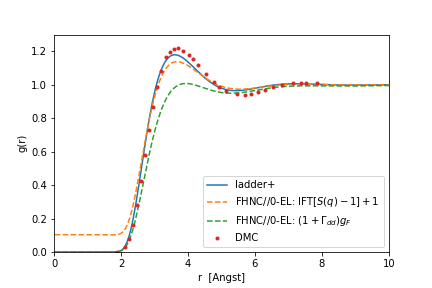Recently I have feed our method1 (ladder+) with the Lennard-Jones potential. The parameters where chosen to resemble the Potential of Helium. (\(e=10.22K\) and \(\sigma=2.556\) Anst.) The result is excellent, as can be seen in the figure below:

We compare to FHNC//0-EL, where the pair distribution is given by \(g(r)=(1+\Gamma_{dd}(r))g_F(r)\). Alternatively one could calculate the pair distribution from the Fourier-transform of the Static structure: \(g(r)=FT^{-1}[S(q)-1]+1\).
- 1.Panholzer M, Hobbiger R, Böhm H. Optimized correlations inspired by perturbation theory. Phys Rev B. 2019;99(19). doi:10.1103/physrevb.99.195156
- 2.Casulleras J, Boronat J. Progress in Monte Carlo Calculations of Fermi Systems: Normal LiquidH3e. Phys Rev Lett. 2000;84(14):3121-3124. doi:10.1103/physrevlett.84.3121
- 3.Egger J, Krotscheck E, Zillich RE. Bose and Fermi Gases with Lennard–Jones Interactions. J Low Temp Phys. 2011;165(5-6):275-291. doi:10.1007/s10909-011-0402-9
